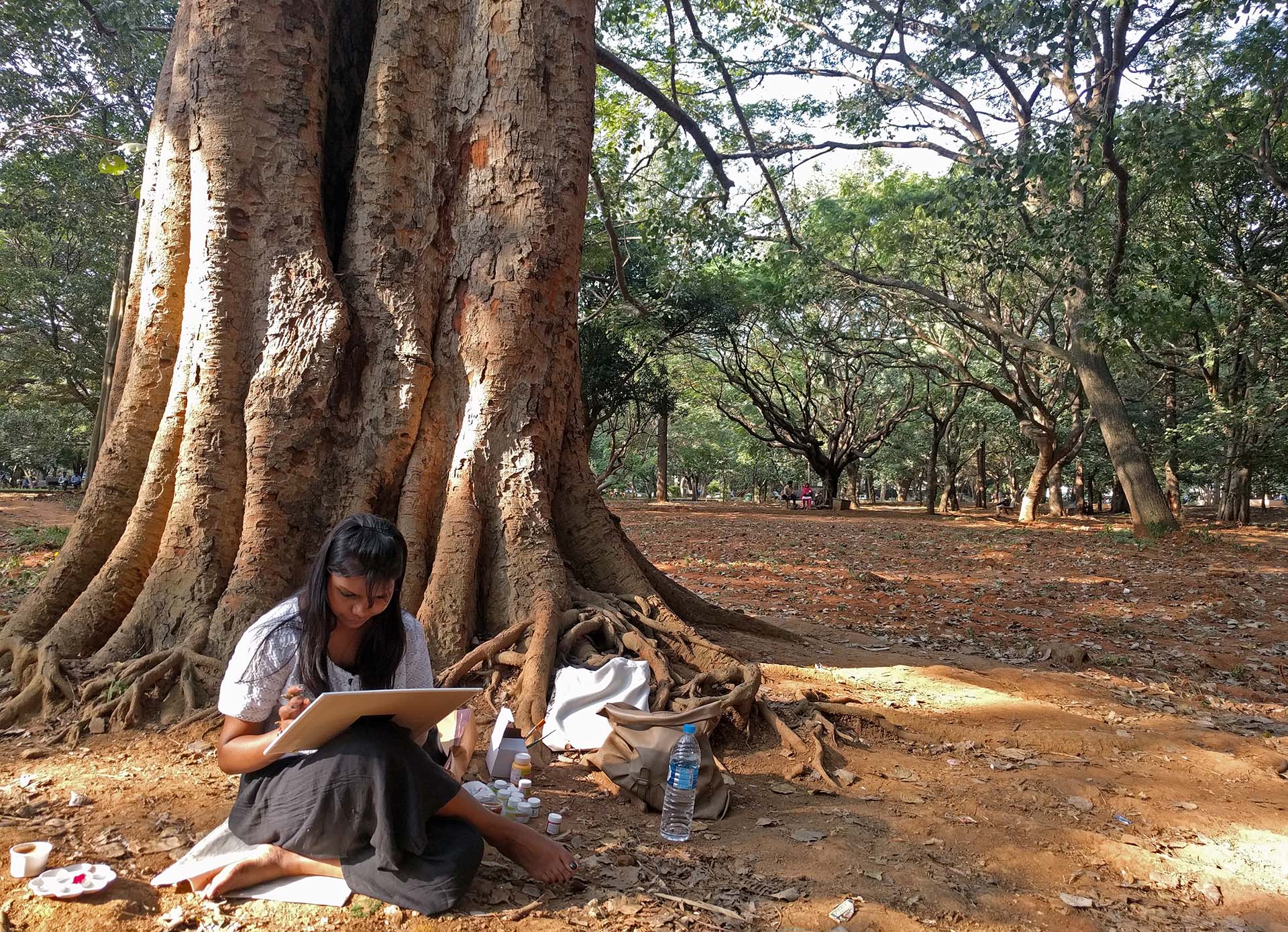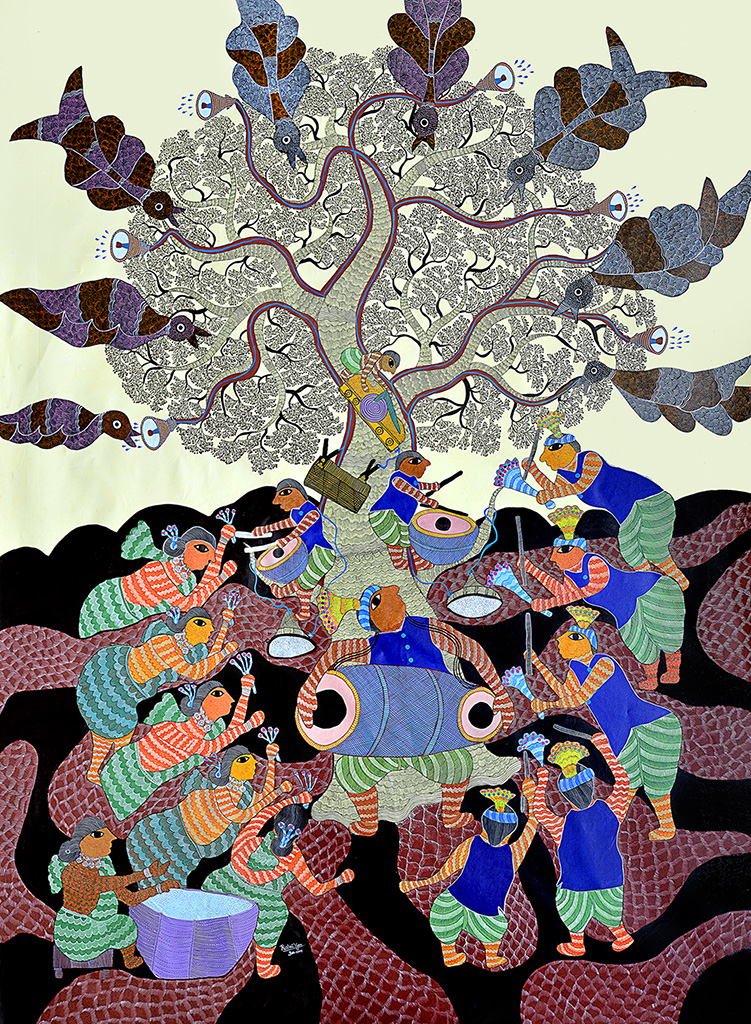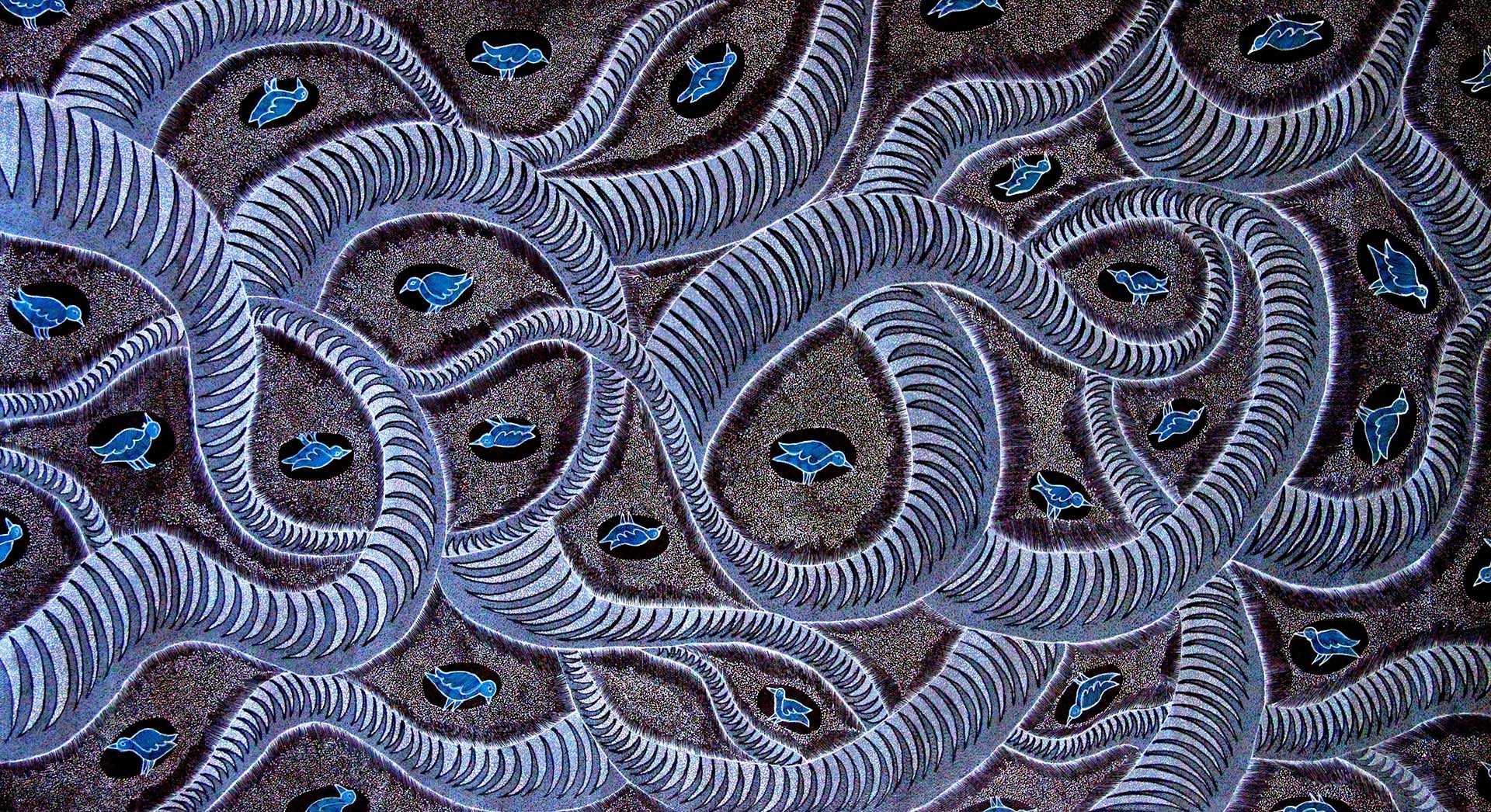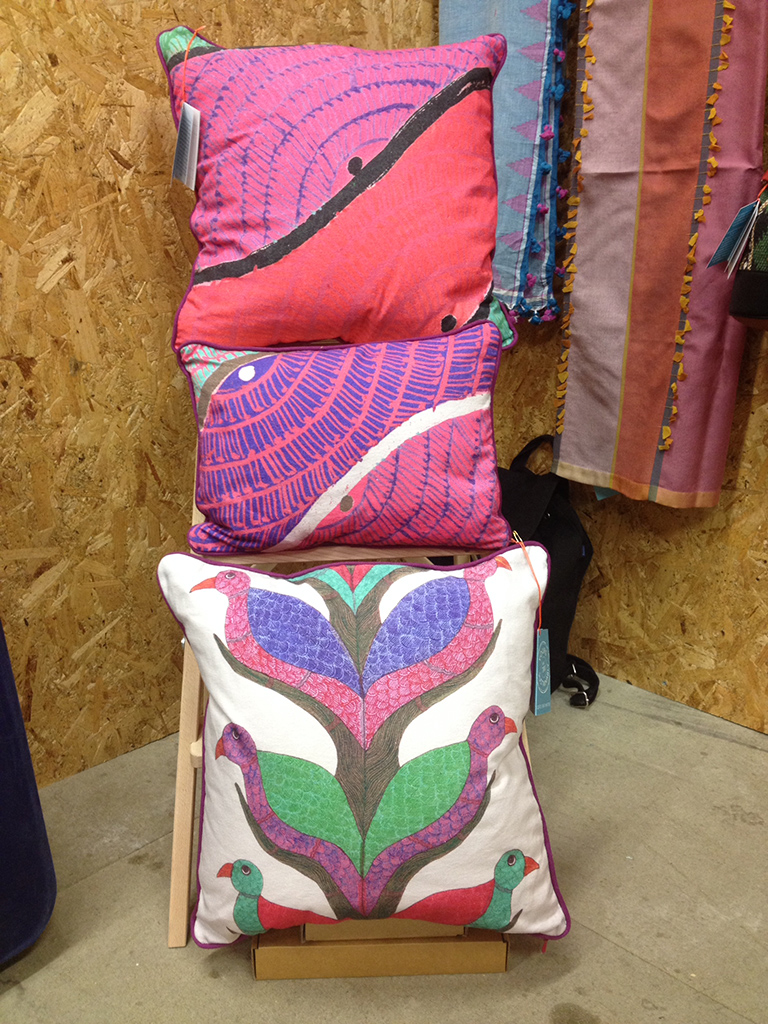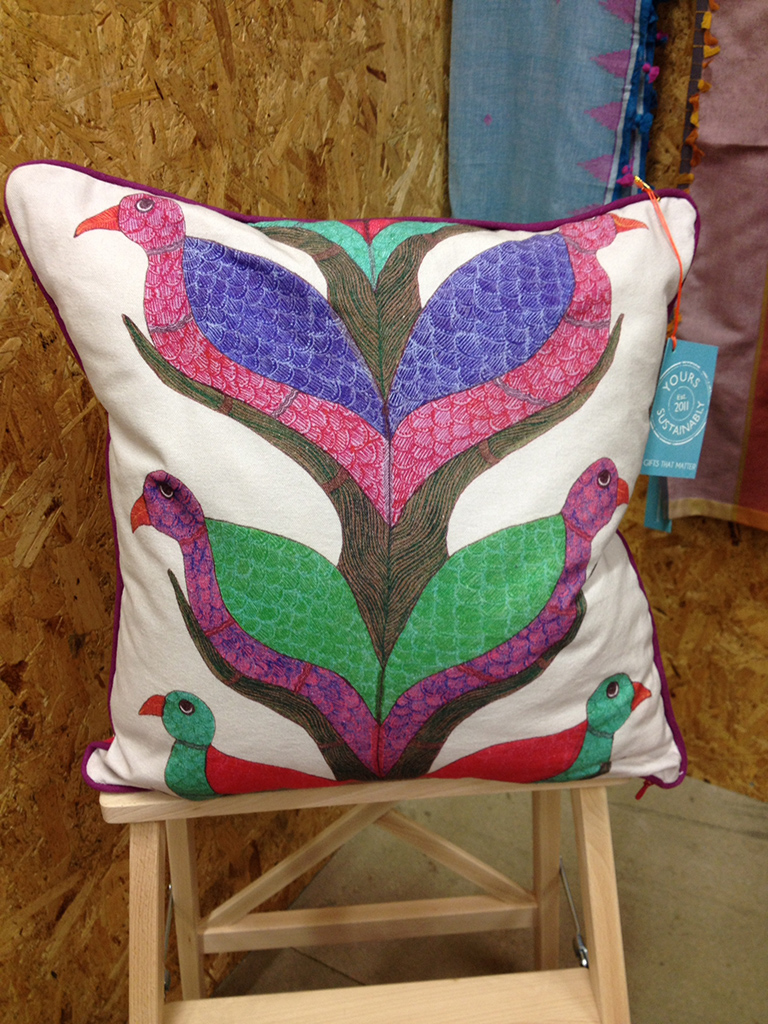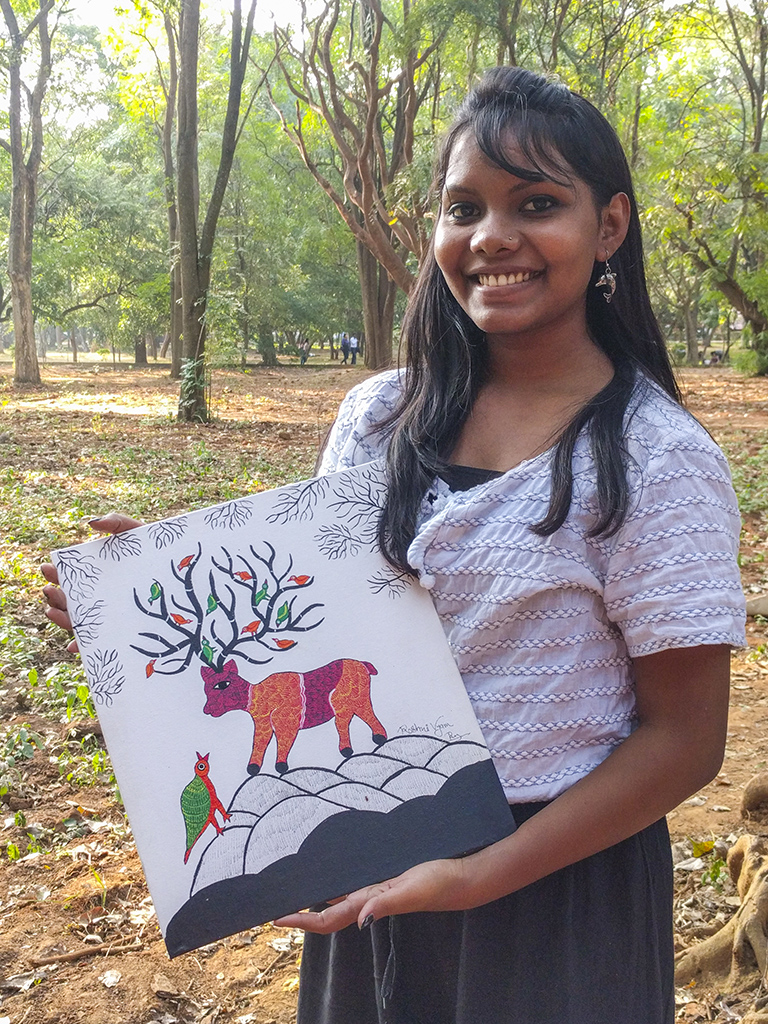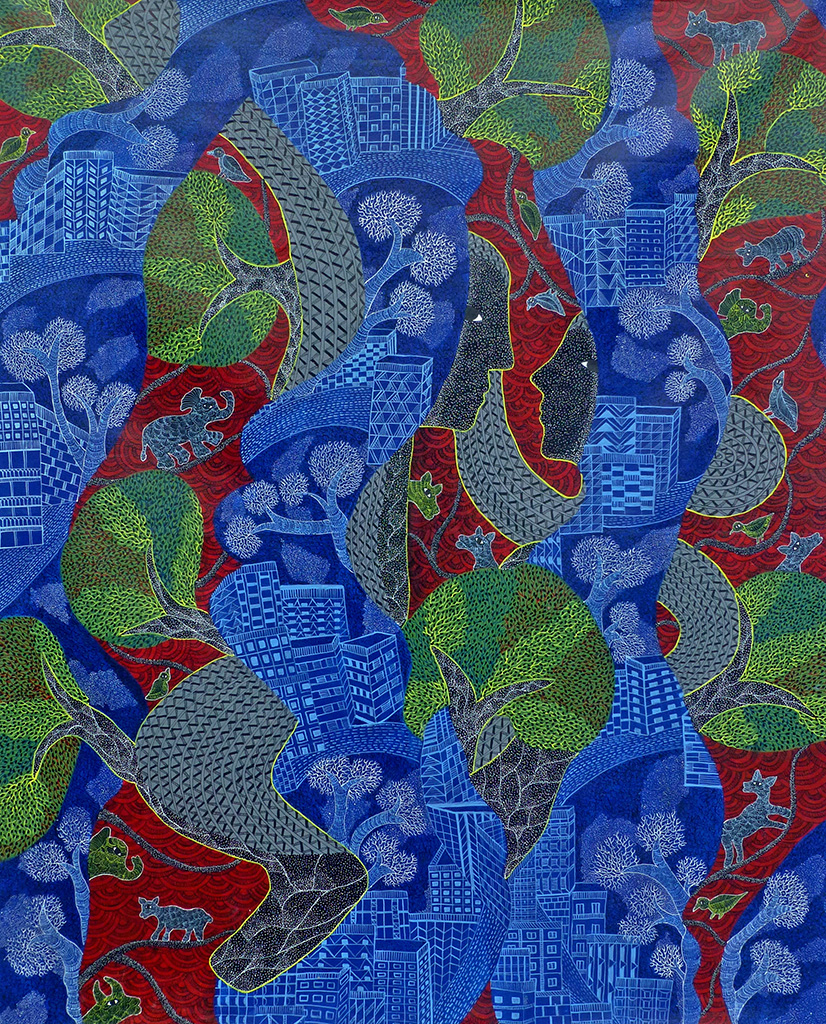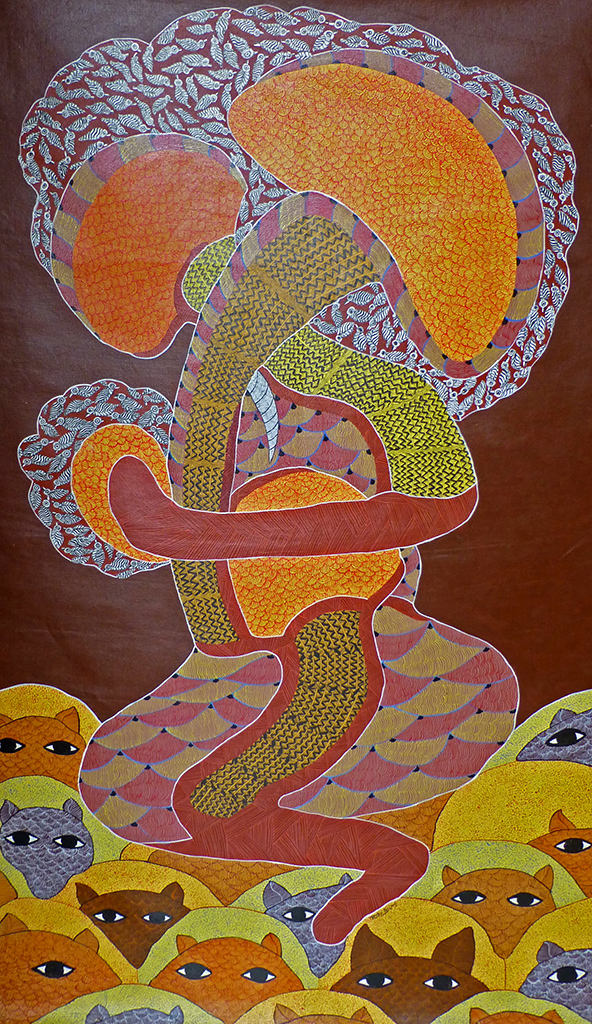Twenty-two-year-old Roshni Vyam thinks branches depict the true form of a tree. She uses this motif in most of her work, whether it is a large, blue-grey canvas painted with little birds in the midst of interconnected branches, or a small, white one with a Barasingha (Swamp Deer) whose antlers host tiny birds. A discussion on branches is the perfect beginning, as we walk around Cubbon Park, Bengaluru, looking for a spot for her to sit and sketch the Barasingha in. She picks a Peepal tree (for the branches, of course) to settle under and takes the blank canvas out of her bag reverently.
Roshni is one of the youngest Gond artists in the country today. The Gonds — a tribe primarily from Madhya Pradesh and its surrounding areas — use nature and wildlife motifs connected to the divine and the sacred in their art. Traditionally, the Gond style of painting involves bright colours and bold sketches on walls; however, over the past three decades, it has found its way onto canvas.
As she paints, Roshni shares stories of her childhood and opens up about her art, her influences, and her plans for the future.
Excerpts from a conversation:
Tell us about the origins of the art form and its connect with nature.
Village women would clean and decorate their houses weekly, or during festivals or weddings; a clean house attracts prosperity. So they started decorating with geometrical patterns — the dhigna form. Slowly dhigna evolved to include birds, animals and trees on the walls. The concepts are evolving further now with the inclusion of urban elements as more artists move out of villages to live in cities.
The origin of the Gond tribes is steeped in nature. The artists have lived in jungles and villages so most of the art is inspired from their own lives but depicted in the form of fauna. For example, if I were to depict a scene from my life, I would draw myself as a bird, not in human form, and paint a vignette around it.
The original artists were predominantly women, yet aren't most well-known Gond artists today men?
I suppose it began with Jangarh mama (celebrated Gond artist Jangarh Shyam is her maternal uncle). Creative even as a child, he helped his mother with decorating the walls. When he was discovered by Jagdish Swaminathan (then director of Bharat Bhavan), he moved to Bhopal to pursue the art form on canvas, and then encouraged others back home to move as well. The men did, but societal norms didn't encourage women to do the same. Now, of course, women are involved in the art form more than ever; a prime example being my mother, Durga Vyam. Her work is unique: most artists use their imagination to create canvasses, whereas she illustrates Gond folklore.
How is the Jangarh art form different from the original Gond? Is the evolution very mainstream?
His medium might have been different (canvas rather than walls, and printing, spraying or acrylic paint rather than natural dye), but Jangarh mama did not believe in limiting expression via art. It is, and will remain Gond art; just presented on a different medium. He has inspired me in not letting the medium restrict my creativity. More people are definitely more aware of the art form, now, not just through workshops and exhibitions but also as a form of therapy. Gond art works beautifully to relax and rejuvenate the mind.
Is enough being done to actually preserve and/ or teach Gond art?
No. The training is completely informal. The (decent) increase in the number of workshops is recent. I’ve perused the syllabi of various art courses and haven't found a single one on traditional folk art. It’d be great if art colleges seriously consider including this along with modern art.
You have studied in NIFT; what are your plans of taking the art to newer mediums?
Gond art is versatile. It’s been on walls, on paper, on canvas, and it has been on textile as well. My training will allow a new aesthetic to the tradition. I don’t want to reduce the essence of the art, but elevate it through a different medium and take it from the niche to the masses. I also want to cut out middlemen by educating my community about the value of what they create and help increase their reach to the rest of the world. I have a responsibility towards the art and my community.
When did you first draw a full-fledged piece of Gond art?
As a child, I would watch Jangarh mama (he passed away in 2000) sit in our courtyard and paint huge canvasses. I’d promised him that, one day, I’d work on canvasses bigger than his. In 2006, I heard about a group show for Gond artists and that there was a book in the making — Jangarh Kalam — that a lot of those artists were working on. My mother encouraged me to contribute as well, and that’s when I consciously started painting. My canvas was a bunch of birds with a 'band baaja baraat' theme. A flock of birds would fly past my house every day and I’d imagine it was a baraat going to a wedding. That was also my first sell-worthy piece of art, when I was in class seven or eight, and on a big canvas.
How and from whom did you learn?
I’ve been accompanying my mother to painting workshops since I was five. I was never formally trained in the style but I see a lot of my parents' influence in my thought process. My father has always been my biggest critic. I don’t remember his feedback on my work as a kid but he has been critiquing my recent work — the choice of colours, especially. My mother, on the other hand, has always been my biggest cheerleader. Growing up, MF Husain was also one of my biggest influences. His name itself is a brand; I’ve been in awe of that ever since I was a child.
How is your style distinct from that of your parents/ uncle?
It might be slightly different but it’s not distinct; I have always made a conscious effort to remain true to the original art form. My patterns or figure-drawing style or my concepts might differ, but our thinking is alike; our imagination is the same. I do have some contemporary knowledge, so if my parents have to work on a piece, they ask me to sketch my idea as well, and the best sketch makes it to the canvas. They prefer village scenes and traditional stories while mine includes urban elements. Mama (Jangarh) also started off with the village concept, but I saw his style change drastically with the inclusion of urban elements after he moved to the city. I’ve always followed his advice: draw what you feel like, don’t restrict yourself; if you’re from a village, you should not use only that experience as basis for your work. Also, every artist has a signature pattern. Mine is the payal.
Why were cats your favourite when you first started painting?
I grew up in a village and there wasn’t much variety when it came to animals. There were a lot of roosters, though, and plenty of cats. Since I’d been around them ever since childhood, that’s what I ended up drawing. The inclusion of other wildlife and nature in my work happened later.
Can Gond art be used to spread awareness about wildlife and nature conservation? What would you do to help?
Since the art form is so deeply rooted in nature and its elements, it’s would be natural, even simple to depict how, say, a particular tree is important for our survival. So yes, it is a wonderful medium to spread awareness about wildlife and nature conservation.
I’d love to work on a children’s book detailing all of Gond folklore — the origin stories of Bamboo, Peepal, bargad, even mahua and ganja. If I can capture children’s imaginations and create awareness about conservation, then that’s half the work done.
As told to Zara Khan
